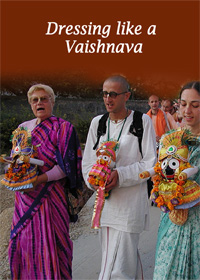Dressing Like a Vaishnava

1. There should be no compromise in our Vaisnava appearance. We are representatives of Srila Prabhupada. We should aim to be first class representatives. 2. We need to be aware of the bonafide standard of appearance, maintain it and preach it. In the age of Kali deviations easily become the standard. We should be alert to this. 3. Proper Vaisnava dress helps us maintain proper consciousness regarding our identity and responsibility in service to Srila Prabhupada and the Vaisnavas. 4. Vaisnava appearance is attractive and will facilitate our preaching. The first impression, which is most often formed from visual stimuli, is the most longstanding. 5. Just be seeing a Vaisnava the conditioned soul is purified.
Quotes from Srila Prabhupada Srila Prabhupada was dressed appropriately for a resident of Vrndavana. He wore kanthi-mala (neck beads) and a simple cotton dhoti, and he carried japa-mala (chanting beads) and an old chadar, or shawl. His complexion was golden, his head shaven, sikha in the back, his forehead decorated with the whitish Vaisnava tilaka. He wore pointed white slippers, not uncommon for sadhus in India. But who in New York had ever seen or dreamed of anyone appearing like this Vaisnava? He was possibly the first Vaisnava sannyasi to arrive in New York with uncompromised appearance. Of course, New Yorkers have an expertise in not giving much attention to any kind of strange new arrival. Lilamrta, Volume 2, p. 7
Episode of a Vaisnava Wearing Tilaka in Muslim Factory There was once a factory in India where all the workers were Hindus, and mostly Vaisnavas. The Vaisnavas had freedom, therefore, to wear their Vaisnava tilaka to work, and they also displayed other Vaisnava paraphernalia. But after some time, the factory went into new management, and then the proprietor was a Muslim. On taking over the business, the Muslim owner declared that he would not allow the workers to come to work any more wearing Vaisnava tilaka. Most of the workers obeyed, and on the given date announced by the owner, they appeared at the factory without their tilaka. One employee, however, thought that he would take his chances and depend on Krsna. So he went to work wearing very clear, white Vaisnava tilaka. After seeing all the workers assembled, the new Muslim proprietor said, "This one devotee who has worn Vaisnava tilaka is very courageous. He may be permitted to continue wearing the tilaka to work. But all others are forbidden to wear it any more." Srila Prabhupada Nectar 3.6
In this way, Prabhupada encouraged the devotees to not unnecessarily abandon the markings of a Vaisnava. Where situations forbid it, Prabhupada said it was not absolutely necessary to wear tilaka, although a devotee should at least put water tilaka on his body with the names of Visnu. But if the paraphernalia is permitted, then a devotee should not unnecessarily do away with the dress or beads of a Vaisnava.
Comment by Satsvarupa Dasa Gosvami: This story has obvious modern day application. In 1966 Srila Prabhupada was pleased when Rupanuga and Satsvarupa persisted in wearing Vaisnava tilaka to their jobs with the NYC Dept of Welfare. Srila Bhaktisiddhanta Sarasvati Thakura also desired that one day the high-court judges may wear Vaisnava tilaka, and this would be a symbol of the successful influence of Krsna consciousness in the world. Even in job situations where wearing tilaka is not permissible, a devotee should try in different ways to remember Krsna while at work. The story told by Prabhupada about the man who insisted on wearing tilaka to his job may remain an inspiration to all devotees who go to places of employment controlled by the karmis. Somehow or other, we must remain as devotees. Gaudiya Vaisnava sikha is an inch and a half across-no bigger. Bigger sikha means another sampradaya. …And they have to be knotted. Lilamrta Volume V p. 93